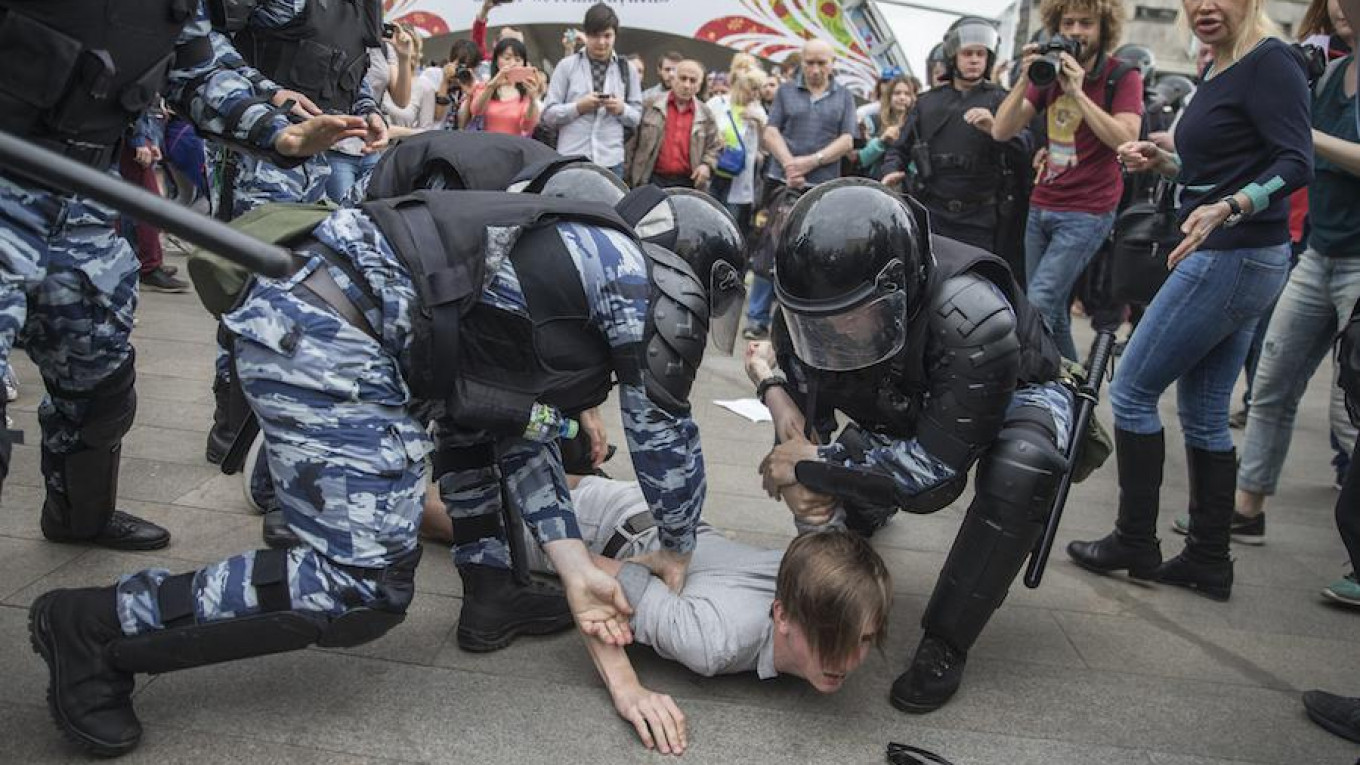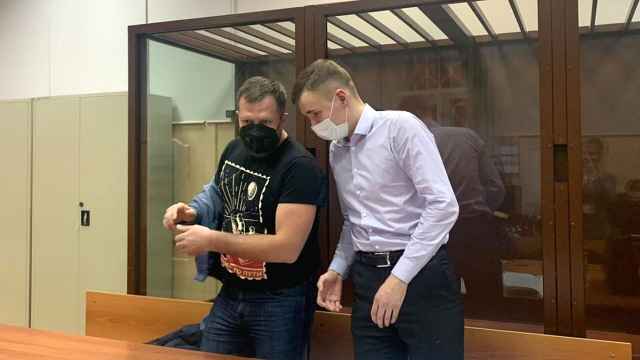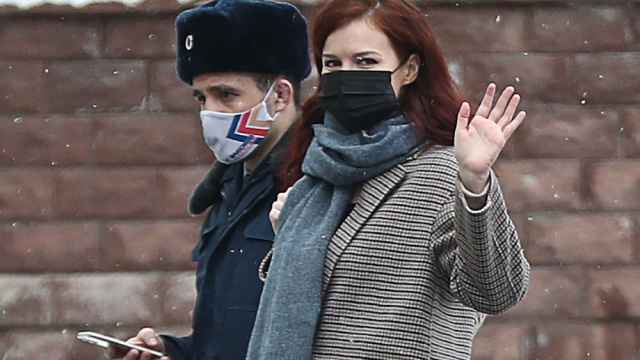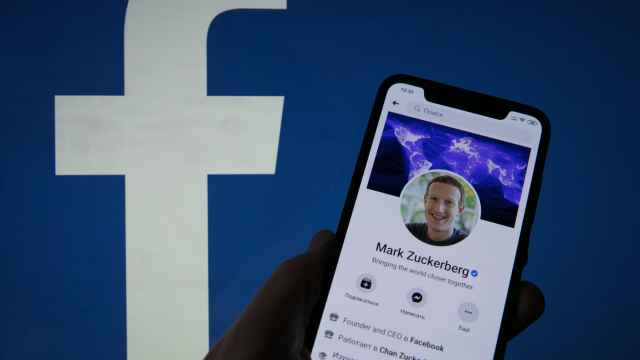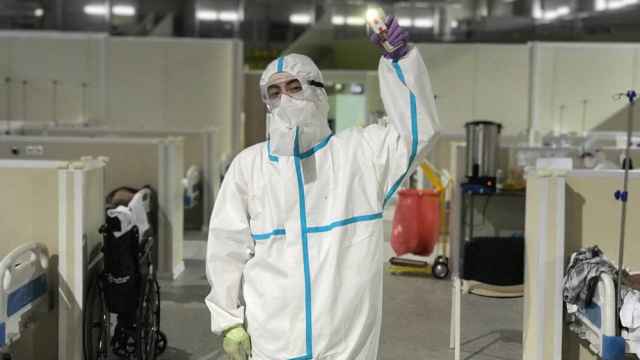As protesters gathered in Moscow on June 12, one thing was clear: This was not a repeat of the 2011-2012 anti-government protests on Bolotnaya Square. You could hear it in the demonstrators’ voices.
Young protesters — few older than their early twenties — were singing the national anthem on Pushkinskaya Ploshchad in the very center of Moscow. With the Russian tricolor painted on their cheeks, they continued singing as riot police dragged protesters off to waiting police vans, one-by-one.
In 2000, soon after taking office, Russian President Vladimir Putin introduced the current anthem. In doing so, he replaced composer Mikhail Glinka’s “Patriotic Song” with an updated version of the Stalin-era Soviet anthem. For many Russians who remember the presidency of Boris Yeltsin, this controversial new anthem symbolizes Putin’s rejection of the 1990s groundswell of Russian democracy.
But for the youth of Russia, it’s just the national anthem — a patriotic tune you’re supposed to sing while protesting against the government. That shift in attitudes may signal a sea change in Russia’s opposition movement.
This new wave of anti-corruption demonstrations erupted three months ago at the behest of opposition leader Alexei Navalny. Unexpected, large numbers of young people turned out to demonstrate in cities across Russia. The face of political protest is now that of a university student or even a high school senior. And the most iconic slogan of the burgeoning movement is “Corruption is stealing our future.”
Over 1700 protesters were detained during Monday’s rallies, with the overwhelming majority of arrests taking place in Moscow and St. Petersburg. Some of these people have received from five to 15 days of administrative arrest. Navalny was sentenced to 30 days of detention. According to OVD-Info, an independent police watchdog, there were many minors among the detained.
In Moscow, the confrontation between protesters and police occurred after Navalny moved the rally to an unauthorized location in the city center: Tverskaya Street, where official celebrations of the patriotic Russia Day holiday were scheduled to take place.
Heavily armed riot police showed little hesitation to use their truncheons as they rounded up young protestors. At least one activist, Yulia Galyamina, was hospitalized with a concussion. Police beat her after she asked them behave in accordance with the law.
The protests were “vile and dangerous provocation,” according to Moscow Mayor Sergei Sobyanin. “We were lucky no blood was spilt,” he later commented.
He wasn’t the only one to consider the rallies provocative. Navalny says he decided to move the protest from its authorized location after the authorities refused to allow him to use necessary sound equipment there.
But his decision to hold the rally on Tverskaya, where the authorities were marking Russia Day, essentially guaranteed a confrontation with police and violent detentions.
Some commentator called the move a deliberately risky mistake. Mikhail Khodorkovsky, a former oil tycoon and now exiled political activist, suggested that provoking the authorities was Navalny’s intention.
“Provocation is a normal political action,” he told Ekho Moskvy radio. “But this time, in my opinion, it was a bit harsh.”
But others suggested that moving the rally to Tverskaya was the only way to make it into a real political demonstration. “By allotting the protesters a specially designated place, the authorities aim to separate the protest from the rest of society and marginalize the participants,” says Kirill Rogov, a political analyst. “Navalny wanted to be in the center of the crowd, so he had to break the rules.”
In the last few months, Navalny has taken a quantum leap, establishing himself as the only true and energetic opponent of Putin in Russian politics. Treated as an outcast by the establishment and totally banned from Russian national television, Navalny has nonetheless achieved nationwide recognizability.
The latest poll by the independent Levada Center showed that 15 percent of Russians were aware of the anti-corruption rallies Navalny was planning for June 12. What’s more, Navalny’s daily Q&A’s on his Youtube channel — held at 20:18 p.m., a reference to his campaign in the upcoming 2018 presidential election — now get hundreds of thousands of hits every day.
Navalny’s platform, often described as populist, is centered on fighting corruption and anti-elite sentiment. His recent political rise began with a YouTube investigation of mansions and yachts allegedly funneled to Prime Minister Dmitry Medvedev as bribes. The video has been viewed millions of times.
In Russia, many blame the elite for the country’s problems instead of Putin. The maxim “Good tsar, bad boyars” has a long history in the country. Some liberal commentators have even accused Navalny of deliberately handling going easy on Russia’s president to avoid antagonizing his base.
But that was hardly the case on June, 12. On Tverskaya, youthful protesters chanted “Putin is a thief!” and “Putin, out!,” two key slogans of the 2011-2012 protests.
However, this new protest wave is far from a victory, warns analyst Rogov, because it is not growing in numbers. The first rallies’ unexpected eruption took the Kremlin by surprise at the end of March, but recent developments are hardly shaking the system, a source close to the Kremlin told to The Moscow Times. Putin has unofficially begun his electoral campaign and is preparing for an easy victory.
But with mass protests becoming Russia’s political reality again, the president cannot feel completely secure. These rallies — and their spread across the country — show that, for millions of young Russians, there is something wrong with the political system. As the election approaches, the protests will most likely radicalize in the fall, predicts political analyst Valery Solovei.
The protests will undoubtedly encounter pushback. The June 12 rally interrupted a historical reenactment performance marking Russia Day. As anti-corruption protesters filled Tverskaya, the pushback was both grotesque and highly symbolic.
Reenactment performers dressed as officers of the Stalinist NKVD — the predecessor to the KGB — continued to play their role: They grabbed protesters and delivered them to the police.
A Message from The Moscow Times:
Dear readers,
We are facing unprecedented challenges. Russia's Prosecutor General's Office has designated The Moscow Times as an "undesirable" organization, criminalizing our work and putting our staff at risk of prosecution. This follows our earlier unjust labeling as a "foreign agent."
These actions are direct attempts to silence independent journalism in Russia. The authorities claim our work "discredits the decisions of the Russian leadership." We see things differently: we strive to provide accurate, unbiased reporting on Russia.
We, the journalists of The Moscow Times, refuse to be silenced. But to continue our work, we need your help.
Your support, no matter how small, makes a world of difference. If you can, please support us monthly starting from just $2. It's quick to set up, and every contribution makes a significant impact.
By supporting The Moscow Times, you're defending open, independent journalism in the face of repression. Thank you for standing with us.
Remind me later.



